Choosing a right racket depends a lot on how you play the game. Are you a dynamic, muscular, aggressive, advanced player, or a willowy, veteran beginner? Badminton is a game for everyone, but the best racket for you is determined by your style and swing speed.
In this article, I will review some of the rackets currently available, which are great for smashing and control and will describe the type of player they are designed to help. Better badminton performance could be just a few clicks away!
#1 Yonex Duora 10

The Duora 10 was the racket used by the best male badminton player of recent times, the legendary Lee Chong Wei. It is therefore clear that this is a racket designed for advanced players.
The Duora 10 offers a fairly even balance, although it is slightly head-heavy, and a stiff shaft. It comes in a 3U weight and a G4 grip size. The frame offers regular ‘box’ construction on one side of the head, and on the reverse, you will see a much sharper “cutting edge.”
Why should you buy this racket? Well, it has a quality feel, and if it was good enough for Lee Chong Wei, it ought to be good enough for the rest of us! Its most exciting feature is its dual-sided design.
The frame is designed in such a way that the racket moves more quickly through the air in one direction than the other. The idea is that it makes it easier to develop speed on your weaker side, which will be the backhand for most players.
If you are an advanced player, the Duora 10 will offer you power and control. If you are a beginner, you will find it too stiff, and you will gain little benefit from the advanced design features.
PROS
- A top racket for advanced player.
- Stiff frame rewards high swing speed.
- A unique frame design allows extra speed on the weaker side.
CONS
- Too stiff for most beginners and intermediates.
#2 Apacs Edge Saber 10
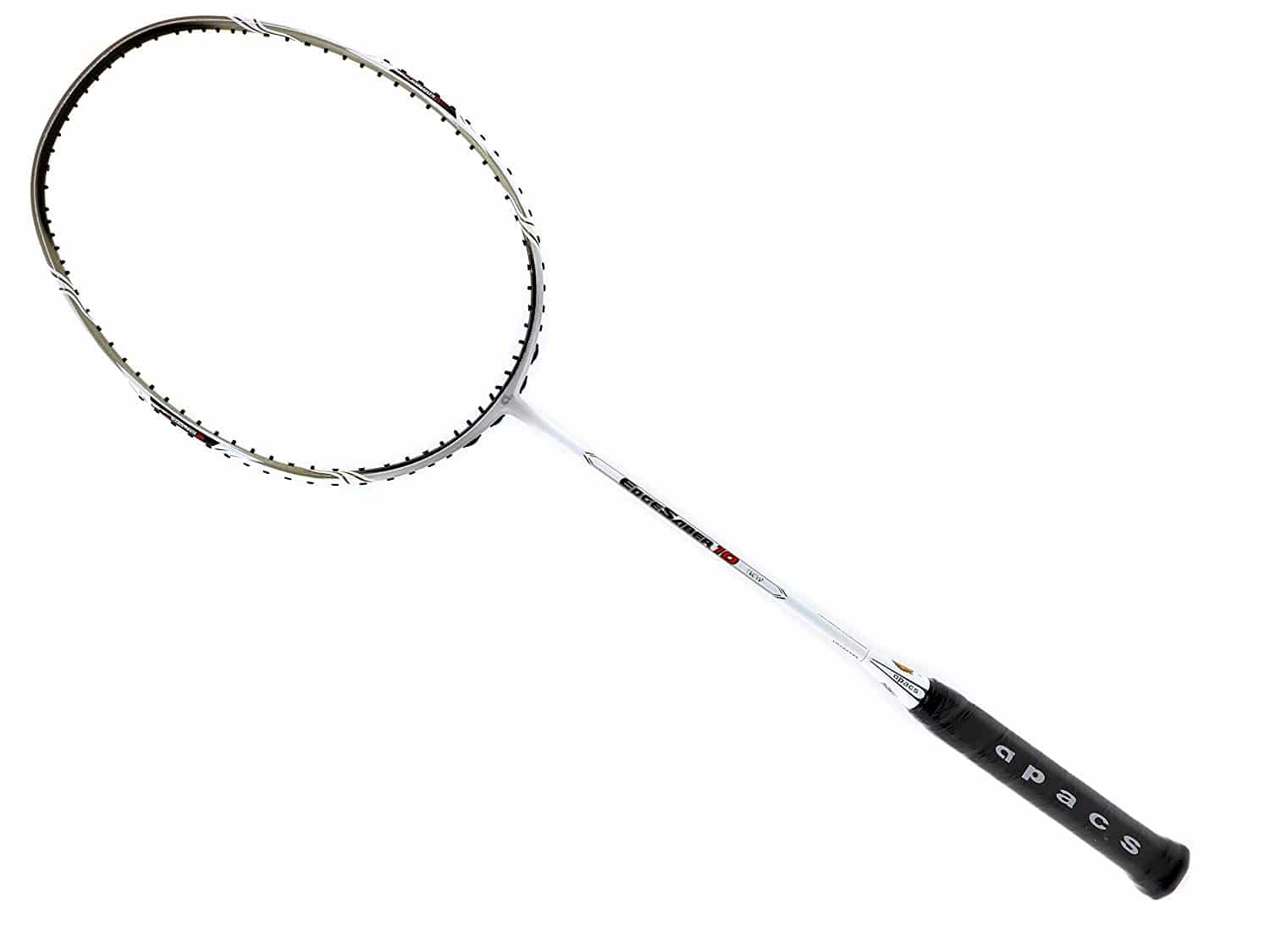
If you are not yet ready to take on the likes of Lee Chong Wei, but you can play the game to a reasonable standard, the Apacs Edge Saber 10 may be just what you need.
This racket is a good all-rounder, available for a very competitive price.
The Edge Saber 10 offers an even balance and a medium-flex shaft. It weighs in at 85g, which is at the lighter end of the 3U category and is renowned for its maneuverability.
The racket has a frame made from high-modulus graphite for solidity and strength and features carbon nanotech for extra durability and power.
PROS
- This racket offers excellent performance for intermediate players.
- Great value for money.
- Suitable for smashing, but remains maneuverable.
CONS
- Not stiff enough for advanced players.
#3 Yonex Voltric Z Force 2

The Z Force 2 is an established racket for advanced players. When it was first released in 2014, Lee Chong Wei used it to win the All England Championships. It is available in two versions, a 3U, and a lighter 4U.
The racket is head-heavy and extra stiff, which means that it will reward the high swing speed of the best players with great power and control. It will not help beginners and intermediates at all, as they will get little power from it.
The Z Force 2 utilizes materials designed to reduce sound on impact, and this also significantly reduces vibration. It means that, despite its stiffness, you will find it comfortable to use.
The shaft of the Z Force 2 was the thinnest Yonex had ever produced, which helps to reduce the overall weight of the racket. You will find that it is head-heavy, but not heavy overall.
PROS
- Extra Stiff for advanced players.
- Head-heavy for power.
- Reduced vibration.
CONS
- Too stiff for beginners and intermediates.
#4 Yonex Arcsaber 11
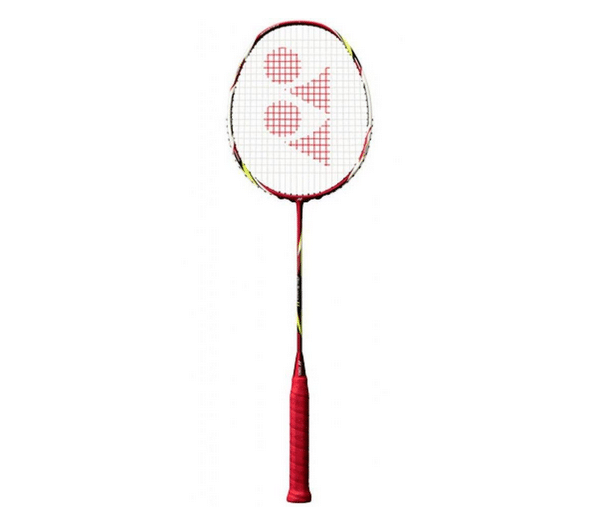
The Arcsaber 11 is another excellent model for professionals and advanced players. It was used and recommended by the great Indonesian player, Taufik Hidayat, and there is a special edition bearing his name.
The racket is fairly evenly balanced, with perhaps a touch of head-heaviness, and has a stiff shaft. Its weight is in the U3 range. The Arcsaber 11 is available in an extra-long version, which offers you additional reach and power.
As an evenly-balanced racquet, the Arcsaber 11 gives you good maneuverability and is excellent for defense and aggressive net-play. Its stiffness is ideal for advanced players with high swing speed, although not for beginners.
The Arcsaber 11 is excellent for smashing, offering you a decent amount of power. It is not, however, as powerful as a head-heavy racket like the Z Force 2. To compensate, it gives you great control, and its lightness allows you to really disguise those drop-shots.
Using the longer version of the Arcsaber 11 will increase the power you can get from it, but it will reduce control and feel.
PROS
- A quality racket for advanced players.
- The stiff frame offers power and control.
- Even balance means it has excellent maneuverability.
- Superb for quick netplay.
- The longer version offers more reach and power.
CONS
- Not suitable for beginners.
- Less powerful than head-heavy rackets.
#5 Yonex Voltric 7
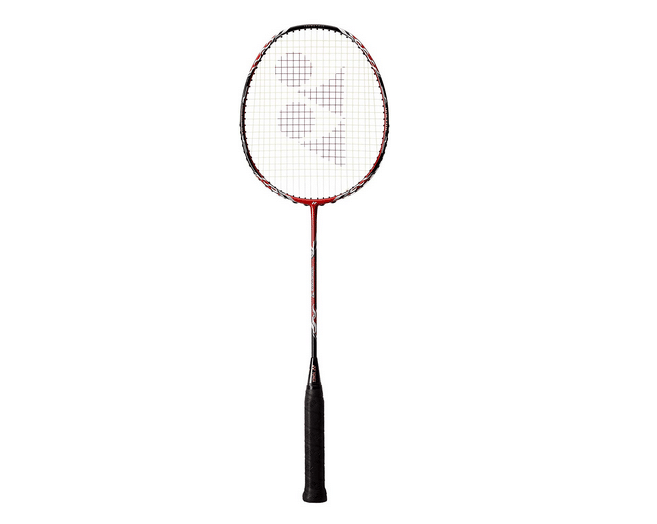
The Voltric 7 is a lightweight racket, categorized as 4U. It offers a medium flex shaft, ideal for club players, and is moderately head-heavy.
The racket is competitively priced at the lower end of Yonex’s performance racket range, but this does not mean that it is of inferior quality. If you are the type of player this racket was designed for, you will find it hard to pick fault with it.
The Voltric 7 offers effortless power to players with moderate swing speed. It is also very maneuverable, thanks to its lightweight, so you will find that it is excellent for defensive play, and those rapid net exchanges that occur in club doubles matches.
Yonex has created a racket, in the Voltric 7, that offers high-quality performance characteristics to club players. The shaft is not stiff enough for advanced players, but it otherwise has few weaknesses.
PROS
- Due to its ultra-fast swings, the shots go fast, effortless, and smooth.
- Great for smashes for players with medium swing speed.
- Lightweight gives excellent defensive control.
- Maneuverable for sharp net exchanges.
CONS
- Too flexible for advanced players.
#6 Yonex Nanoray Light 11i
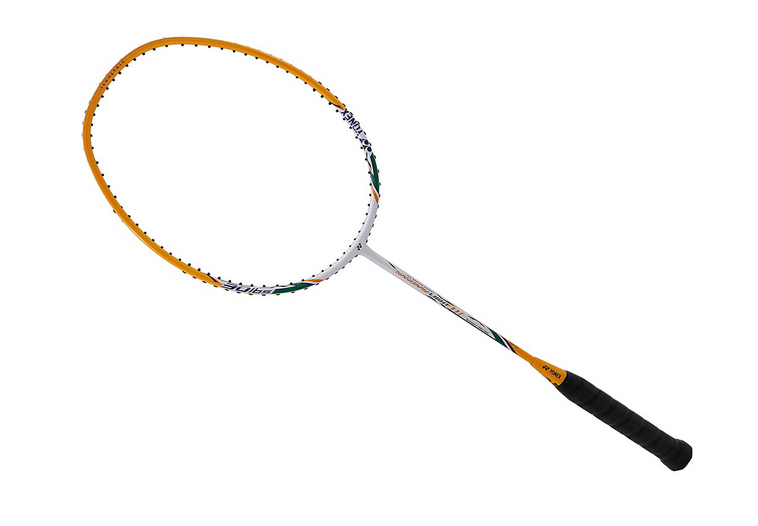
If you are a beginner or club player looking for an affordable yet good quality racket from a major manufacturer, the Yonex Nanoray Light 11i may be just what you need.
The Nanoray Light 11i is a very light racket, coming in the 5U range at around 75g. It is also equipped with a flexible shaft and a head-heavy balance, which will give plenty of effortless power to you if you don’t generate a lot of swing speed.
The racket is made from high modulus graphite, with an aero-box frame to minimize air-resistance and help you to swing faster. Combine this feature with its lightweight, and you have a supremely maneuverable racket.
The Nanoray Light 11i is suitable for defensive situations and netplay because you can adjust its position quickly, and it is excellent for giving club players that little bit extra on the smash thanks to its flexibility and head-heavy balance.
PROS
- Light and maneuverable.
- The racket offers extra power to club players with modest swing speeds.
- Affordable.
CONS
- Far too flexible for advanced players.
#6 Senston N80
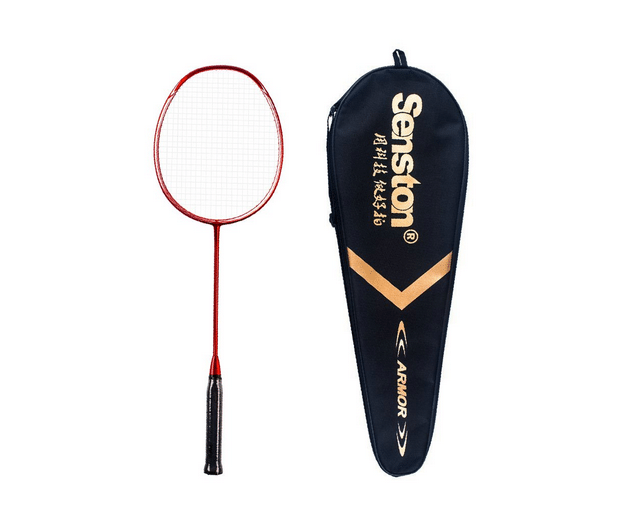
It is a good budget choice for beginners and intermediate players. The N80 is a lightweight, U5 racket, with a fairly even balance. It has an isometric frame that offers a larger sweet spot than a racket with a traditional round head.
Despite its low price, the N80 features carbon fiber construction. It has a flexible shaft, making it easier for beginners and intermediate players to get more power. Its lightweight makes it maneuverable.
If you are relatively new to badminton, the N80 could be an excellent choice for you. You will feel that you can get a reasonable amount of power, but the racket will still be easy to control.
The only criticism aimed at the N80 is that its durability is questionable during heavy use. So if you are planning to do lots of tough training, you probably need to look for something more lasting.
PROS
- Very affordable.
- Great for maneuverability and control.
- The flexible shaft will help players with slow swing speed.
CONS
- Too flexible for advanced players.
- There is a question mark over long-term durability in intensive use.
#7 Victor Jetspeed S10 – Q
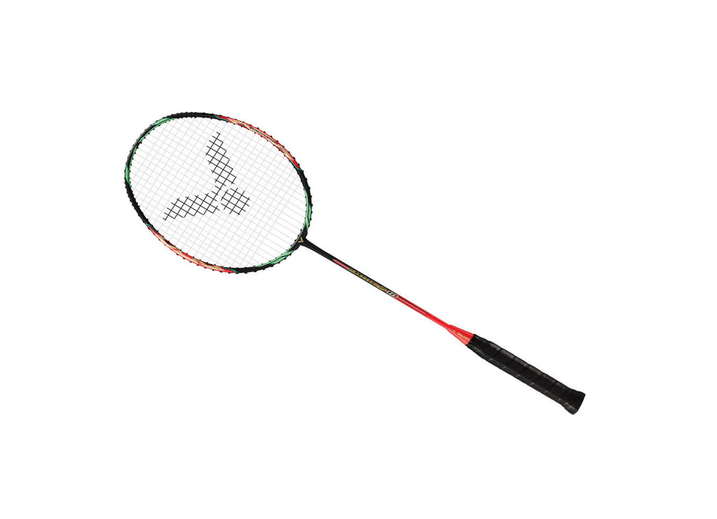
The Jetspeed S10-Q is a racket aimed squarely at advanced players and has proven extremely popular amongst tournament players not restricted by sponsorship deals.
The racket is widely available in 3U and 4U weights. It has an even balance and a moderately stiff frame. It is commonly used in a 4U guise, which gives it a light feel. The shaft is thin, and the head is on the small side.
The first thing you will notice when you start playing with the S10-Q is the speed of the frame. It might just be the fastest frame you have ever used, and you may need to spend some time readjusting your timing before you can get the most from it.
The speed of the frame allows you to get extra power in your smash, despite the even-balanced nature of the racket. The light and speedy frame make sure you are well-equipped for defensive rallies and netplay too.
The S10-Q is perhaps as close as you can get to a racket, which is excellent for both smashing and control. It would be too stiff for inexperienced players, but otherwise, it has few flaws.
PROS
- Fast.
- Light.
- Maneuverable.
- Plenty Of Power
CONS
- Not suitable for players with slow swing speed.
Choose Your Badminton Racquet For Smash and Control With Confidence
INTRODUCTION
If you are a keen badminton player, you will know that many different elements can give you that winning edge. Improving your fitness and technique helps, but using the wrong racket will always hold you back.
Virtually all badminton players love the feeling of hitting powerful, accurate smashes, so you will almost certainly want a racket that is great for smashing. It’s no use if you can’t keep the shuttle in court, however, so the ideal racket needs to offer good control too.
How do you know if a racket will give you what you need? Two key factors are the balance and flexibility of the shaft.
BALANCE
It means where the weight of the racket is located. Most of the mass of a ‘head-heavy’ racket is located in the head, whereas that of a ‘head-light’ one is located towards the handle. If a you found a model that has an ‘even balanced,’ the mass is more evenly distributed.
A head-heavy racket will give you the most power- it’s just physics! If you can develop the same swing speed, a head-heavy racquet will carry the most momentum, and, when it strikes the shuttle, a faster shot will result.
Head-light rackets are more maneuverable and are best for defensive play, or the kind of quickfire reaction play which is often needed in doubles.
As you might expect, an even-balance racquet offers a compromise. A good even-balance racket will combine power with maneuverability and could be ideal for players who want something which helps with all aspects of their game.
FLEXIBILITY
The flexibility of a racket’s shaft is crucial in determining how it plays. Rackets are generally categorised as ‘stiff’, ‘medium’, or ‘flexible’. So, how do you work out which is best for you?
The critical factor here is what we call your ‘swing speed,’ or the speed of your arm/wrist as you are hitting the shuttle. A beginner will typically have a fairly low swing speed, whereas an advanced player with an excellent technique will develop a lot of speed.
If you are a player who develops a high swing speed, you will want a racket with a stiff shaft. A player with a fast arm who uses a flexible racket will lose control of the shuttle and will not gain extra speed, as the head area will move in unpredictable ways.
A racquet with a stiff shaft will bend and recover quickly so that it will offer the most power and control to a player with a fast swing.
If you are a beginner or an older player, you are likely to have a slower swing speed, in which case the assistance offered by a flexible shaft could help you. A stiff shaft will not flex sufficiently for you, and you will feel that it lacks power.
STRING
A higher string tension generally gives you more control, while a lower tension can produce more power. A thinner string can provide more control but is more prone to breakage. All of this can be adjusted by restringing once you have made a purchase.
FINAL THOUGHTS
I have looked at eight excellent badminton rackets here. As I explained at the beginning of this article, there is no ‘one size fits all’ answer to which badminton racket is best for smashing and control.
Firstly, the more powerful a racket is, the less control you are likely to have. Whilst some rackets combine both characteristics well; there will always be an element of compromise if both of these features are important to you.
Secondly, the right racket for you is determined by your technique, physique, and how you play. Just because a racket did great things in the hands of a highly trained athlete like Lee Chong Wei, this does not necessarily mean that it is the best one for you.
Given this, I can split the results of my analysis for best badminton racket for smash and control into three sections.
For a beginner:
The SENSTON N80 takes the prize here. It is affordable and does everything competently, with a flexible shaft to give a bit of added power.
For a club player:
The Yonex Voltric 7 is the winner in this category. With a medium-flex shaft and excellent maneuverability, it is a high-quality racket aimed at club players.
Honorable mentions in this section go to the Apacs Edge Saber 10 and the Yonex Nanoray Light 11i, both of which offer good performance at a lower price.
For an advanced/tournament player:
Here it has to be the Victor Jetspeed S10-Q, which offers power, control, and incredible speed. Nonetheless, the various offerings from Yonex reviewed here run it pretty close. The Z Force 2 and Duora 10 are probably the best choices if you prefer Yonex.
If you buy any one of the rackets reviewed here, your badminton is almost certain to improve. Keep working on your technique and fitness, buy a racket that suits your style, and soon you will be playing your best ever badminton.
